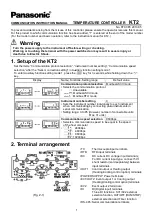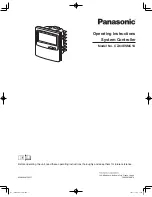
5.7 H: Terminal Functions
204
YASKAWA ELECTRIC SIEP C710616 30B YASKAWA AC Drive T1000A Technical Manual
n
Multi-Function Analog Input Terminal Settings
for information on how H3-02, H3-10, and H3-06 determine functions for terminals A1, A2, and A3.
Note:
The scaling of all input functions depends on the gain and bias settings for the analog inputs. Set these to appropriate values
when selecting and adjusting analog input functions.
Table 5.23 Multi-Function Analog Input Terminal Settings
Setting 0: Frequency bias
The input value of an analog input set to this function will be added to the analog frequency reference value. When the
frequency reference is supplied by a different source other than the analog inputs, this function will have no effect. Use
this setting also when only one of the analog inputs is used to supply the frequency reference.
By default, analog inputs A1 and A2 are set for this function. Using A1 and A2 at the same time increases the frequency
reference by the total of all inputs.
Example: If the analog frequency reference from analog input terminal A1 is 50% and a bias of 20% is applied by analog
input terminal A2, the resulting frequency reference will be 70% of the maximum output frequency.
Setting 1: Frequency gain
The input value of an analog input set to this function will be multiplied with the analog frequency reference value.
Example: If the analog frequency reference from analog input terminal A1 is 80% and a gain of 50% is applied from
analog input terminal A2, the resulting frequency reference will be 40% of the maximum output frequency.
Setting 2: Auxiliary reference 1
Sets the auxiliary frequency reference 1 when multi-step speed operation is selected.
for details.
Setting 3: Auxiliary reference 2
Sets the auxiliary frequency reference 2 when multi-step speed operation is selected.
for details.
Setting 4: Output voltage bias
Voltage bias boosts the output voltage of the V/f curve as a percentage of the maximum output voltage set to E1-05 (200
V for 200 V class drives, 400 V for the 400 V class). Available only when using V/f Control.
Setting 5: Accel/decel time gain
Adjusts the gain level for the acceleration and deceleration times set to parameters C1-01 through C1-08.
The acceleration time used by the drive is calculated by multiplying the this gain level to C1-
as follows:
C1-
×
Accel/decel time gain = Drive accel/decel time
Figure 5.69
Figure 5.69 Accel/Decel Time Gain with Analog Input Terminal
Setting
Function
Page
Setting
Function
Page
0
Frequency bias
D
Frequency bias
1
Frequency gain
E
Motor temperature (PTC input)
2
Auxiliary frequency reference 1
F
Through mode
3
Auxiliary frequency reference 2
10
Forward torque limit
4
Output voltage bias
11
Reverse Torque Limit
5
Accel/decel time gain
12
Regenerative torque limit
6
DC Injection Braking current
13
Torque limit using torque reference/speed limit
7
Torque detection level
14
Torque compensation
8
Stall Prevention level during run
15
General torque limit
9
Output frequency lower limit level
16
Differential PID feedback
B
PID feedback
1F
Through mode
C
PID setpoint
41
Output voltage gain
100%
50%
0
5 V
10 V
1V 2V
20%
10%
Acceleration/deceleration gain from 1 to 10 V
(10 V)
Input Voltage (V)
×
10 (%)
=
Содержание T1000A
Страница 4: ...4 YASKAWA ELECTRIC SIEP C710616 30B YASKAWA AC Drive T1000A Technical Manual...
Страница 32: ...1 5 Component Names 32 YASKAWA ELECTRIC SIEP C710616 30B YASKAWA AC Drive T1000A Technical Manual...
Страница 104: ...4 10 Test Run Checklist 104 YASKAWA ELECTRIC SIEP C710616 30B YASKAWA AC Drive T1000A Technical Manual...
Страница 334: ...7 5 Drive Replacement 334 YASKAWA ELECTRIC SIEP C710616 30B YASKAWA AC Drive T1000A Technical Manual...
Страница 362: ...A 6 Drive Derating Data 362 YASKAWA ELECTRIC SIEP C710616 30B YASKAWA AC Drive T1000A Technical Manual...
















































